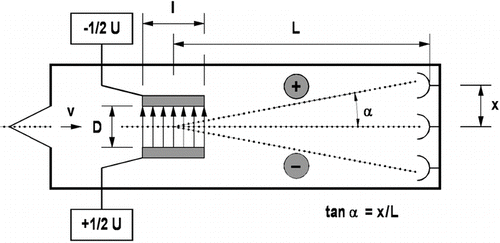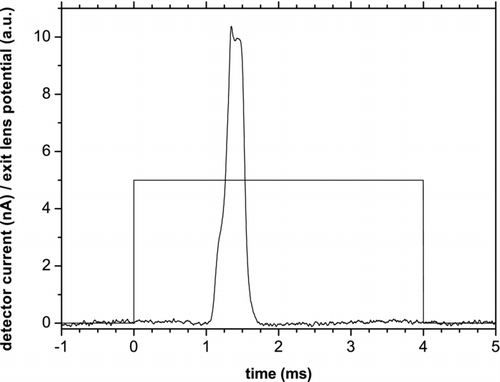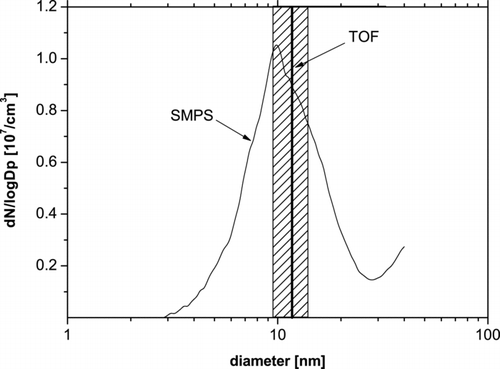Abstract
We present an experimental setup that allows the injection of charged nanoparticles in a diameter range of 3–15 nm into a vacuum chamber and their storage there in an electrodynamic cage. The nanoparticle density in the trap is limited by space charge and can be several orders of magnitude higher than in a free nanoparticle beam. The setup provides for the first time a tool for the application of advanced techniques of spectroscopy to free nanoparticles in this size range. It consists of a combination of (1) a plasma discharge nanoparticle source that generates a high density of nanoparticles of various composition suspended in helium carrier gas at a pressure of about 10–150 mbar, (2) an aerodynamic lens optimized for small particles (diameter 3–15 nm) that forms a well-collimated beam of charged nanoparticles and focuses it into (3) an octopole ion trap operated at low frequencies and filled with helium buffer gas at 10−2 mbar in order to moderate and store the nanoparticles at densities of more than 107 cm−3.
1. INTRODUCTION
Nanoparticles in the 5–50 nm diameter range have found widespread application in science and technology ranging from atmospheric science over quantum computing applications to pharmaceutical formulations (CitationShaw and Liu 2008). Their properties are often strongly size dependent and in many cases a result of quantum confinement effects (CitationKruis et al. 1998). In many natural condensation processes, the initial embryo particles are in the 10 nm diameter range. Such nanoparticles are, therefore, of considerable interest in atmospheric science. More specifically, nanoparticles formed by the condensation of evaporating meteorite material are thought to constitute the nuclei for the formation of noctilucent clouds in the mesosphere (e.g., CitationGadsen 1982; CitationRapp and Lübken 2004).
Many of the interesting properties of nanoparticles are only observable in isolated particles, as the interaction with matrices, surfaces, or among themselves strongly modifies the optical and chemical properties of the particles, even if insolating surfactants are used for stabilization. Individual trapped nanoparticles with diameter > 100 nm have recently been characterized with synchrotron light (CitationGrimm et al. 2006). Smaller nanoparticles in the gas phase are much more difficult to assess experimentally due to the inherently low target density (CitationWang et al. 2006; CitationZiemann et al. 1995). The lifetime of d = 10 nm airborne nanoparticles with respect to coagulation and coalescence processes falls below 10 s if their density exceeds 108 cm−3. In order to avoid diffusion driven loss, beams of nanoparticles in the vacuum have been prepared by expanding aerosol through a nozzle (CitationShu et al. 2006b). The particle density in vacuum beams is much lower than in the primary aerosol, since the gas volume expands as the pressure drops. If an aerosol containing 106 particles per cm3 is expanded from ambient pressure into a vacuum of 10−4 mbar, the particle density at the position of the experiments is limited by the gas expansion to roughly 0.1 cm−3. The conditions become less favorable, if better vacuum or high target density is required. Therefore, such beams are often combined with aerodynamic focusing (e.g., CitationShu et al. 2006a). Usually, this focusing is limited to the size regime above 50 nm (CitationShu et al. 2006b). A combination of aerodynamic focusing of nanoparticles into an ion guide similar to our concept was described earlier (CitationWang et al. 2006) and used for nanoparticle analysis with laser ablation mass spectrometry.
In this contribution, we describe an experimental setup designed to generate very high density targets of very small gas phase nanoparticles with 3–15 nm diameter, which is suitable for optical and X-ray spectroscopy. The high density is achieved by combining (1) microwave driven gas phase synthesis of nanoparticles under low pressure conditions, (2) efficient aerodynamic focusing of the particles into the vacuum chamber, and (3) moderation and storage of the nanoparticle beam in a gas-filled octopole ion cage. With the combination of these stages, the target density could be increased by about seven orders of magnitude compared to state-of-the-art particle production and free expansion from ambient pressure as assumed in the example above. The assembly presented here forms a part of the TRAPS (Trapped Reactive Atmospheric Particle Spectrometer) apparatus which is currently under development for spectroscopy of free nanoparticles under the well-controlled conditions of the mesosphere. The article is organized as follows: In section 2 the setup of the three main components of the apparatus is described and results from simulation calculations that led to their respective design are presented. In section 3, first benchmarks results on the performance of the setup are shown and compared to prior expectations. An outlook on the potential application of such an assembly for various types of spectroscopy will be finally given.
2. EXPERIMENTAL
An overview over the setup is given in . Nanoparticles are produced in the Microwave Plasma Particle Source (MPPS); they enter the TRAPS device through a Flow Limiting Orifice (FLO), pass the AeroDynamic Lens (ADL) where the particle beam is focused at the SKiMmer (SKM). Depending on the device used, the particles now enter either a Particle Mass Spectrometer (PMS) or an ElectroDynamic Cage (EDC) of the TRAPS device where they can be trapped by an electric potential at the inlet lens (Lin) and the exit lens (Lout). When the exit lens is switched to ground, the particle beam passes a quadrupole bender and is detected by one of the Faraday Cups (FC n ). The corresponding levels of pressure are depicted in the lower graph of .
FIG. 1 Schematic diagram of the experimental setup consisting of a Microwave Plasma Particle Source (MPPS), Flow Limiting Orifices (FLO) Skimmers (SKM), AeroDynamic Lens (ADL), Particle Mass Spectrometer (PMS) ElectroDynamic Cage (EDC) with entrance and exit lens (Lin, Lout), and Faraday Cups (FC n ). For details see the text. The corresponding levels of pressure are depicted in the lower graph.
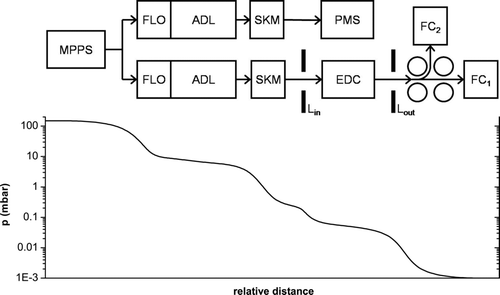
2.1. Particle Generation and Characterization
As detailed below, the nanoparticles have to be suspended in helium for efficient transfer into vacuum via an aerodynamic lens. This might appear as limitation of the TRAPS device since it excludes direct ambient aerosol inlet. However, nanoparticles with diameter < 30 nm exhibit a rather short atmospheric lifetime. For the investigation of small nanoparticles it is therefore convenient to synthesize the particles instantaneous prior to examination. Many nanoparticles sources, such as plasma reactors, spark generators, nebulizers and electrospray sources, can be operated with helium as carrier gas. Once the particles are transferred into the vacuum device, they can be exposed to realistic atmospheric compositions in a subsequent particle trap. In this contribution a microwave plasma reactor was chosen as a particle source since it provides 3–15 nm SiO2 and Fe2O3 particles at high concentrations (109–1012 cm−3 in a 10–150 mbar helium atmosphere) by plasma decomposition of precursor gases. Details of this device have been given earlier (CitationSzabo et al. 1997; CitationSzabo and Vollath 1999; CitationBaumann et al. 2006; CitationMätzing et al. 2009). In order to produce SiO2 nanoparticles a gas flow (4500 sccm) of 0.02% SiH4 in helium and 4% O2 in helium was fed through to a microwave discharge in an homemade resonator (max power 1250 W at 2.45 GHz). In the microwave plasma zone particles nucleate and grow to sizes ranging from 3 to 15 nm according to the different parameters of the plasma, precursor pressure and residence time in the reactor tube, temperature in the plasma zone, and flow rate of precursor and carrier gas.
Nanoparticles produced in the plasma reactor have been characterized by CitationSzabo et al. (1997) and CitationBaumann et al. (2006) by using transmission electron microscopy, particle mass spectrometry and quartz crystal microbalance measurements. On line characterization of the nanoparticles is achieved by an electrostatic deflection particle mass spectrometer (PMS, CitationPaur et al. 2005). It operates by deflection of a chopped particle beam in a homogeneous electric field (). By varying the deflection voltage, particles of different energy-to-charge ratios reach the Faraday cup, which is located at a fixed off-axis position at the end of the detection chamber.
The current signal generated at the Faraday cup is proportional to the incoming number of particles multiplied by their average charge. To convert this spectrum into a particle diameter distribution, the average number of charges z, the particle speed v and the material density ρ must be known. The investigations of Baumann et al. show comparable results obtained from PMS and Transmission Electron Microscopy (TEM) measurements (CitationBaumann et al. 2006; CitationMätzing et al. 2009). The approximate diameter of the material sampled from the molecular beam was determined by TEM. However, the sampling and micrograph analysis of these particles by TEM appear to be difficult which is due to the poor contrast of amorphous SiO2 particles and overlapping of particles. A typical mass spectrum of SiO2 nanoparticles from the microwave plasma synthesis achieved by the PMS is shown in . The M1- peak recorded using the aerodynamic lens (ADL) (full line) corresponds to a particle diameter of 5.7 nm with a FWHM of 0.6 nm.
FIG. 3 Transmission efficiency of a molecular beam inlet with and without aerodynamic lens. The graph shows the signal intensity over deflection voltage of the ion beam measured by the PMS instrument. Data points are connected by a spline in order to identify the two peaks occurring from the charge states. Data points measured without the ADL are multiplied by a factor of 100.
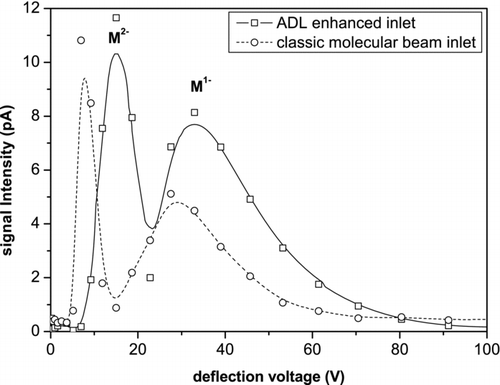
For further particle characterization, the TRAPS apparatus can be used as a time-of-flight spectrometer, as discussed in paragraph 3.4.
2.2. Aerodynamic Lens Inlet and Differential Pumping Stage
One major innovation of the TRAPS instrument is the efficient particle inlet for small nanoparticles provided by an optimized, tunable aerodynamic lens. Transferring small, airborne particles into vacuum by an aerodynamic lens (ADL) is well understood for most demands. Liu et al. have provided pioneering work in focusing fine particles by a series of contractions and expansions of a gas flow caused by a set of orifices (CitationLiu et al. 1995a, b). A critical orifice limits the gas flow through the ADL. It is usually located far enough upstream from the first orifice to ensure a fully developed laminar input flow for the ADL.
ADLs for many particle types and different vacuum system have been designed since then. Huffman et al. give a comprehensive review of the characteristics and performance of most ADL systems (CitationHuffman et al. 2005). These systems achieve optimal particle beam focusing in a diameter range between 100 nm and 1 μ m (CitationLee et al. 2008). In 2006, Wang and McMurry provided the aerodynamic lens calculator (referred as ALC herein, Wang et al. 2006) a valuable design tool, that enables to design an ADL for any particle diameter range and vacuum system without extended knowledge of aerodynamic simulations. This tool is based on several approximations, which tend to become inaccurate, when particles with a diameter below 30 nm are considered (CitationLee et al. 2008).
Few groups have reported ADLs for smaller nanoparticles: To our knowledge the first work concentrating on particles < 30 nm was published in CitationWang et al. (2005). However, that the focusing performance reported for these lenses is comparatively poor for particles < 20 nm (CitationWang et al. 2006; CitationPassig et al. 2006). For example, Passig et al. have only been able to enhance the particle transmission efficiency through a skimmer system by a factor of two for 10 nm particles by using an ADL designed to the guidelines of CitationWang et al. (2006). (See in CitationPassig et al. 2006.)
There are basically three reasons for the difficulty of focusing small nanoparticles: First, the minimum achievable divergence of the beam is dominated by Brownian motion for small nanoparticles. A high axial speed of the particles reduces this effect (CitationWang et al. 2006). Second, the slip motion of the particles, when the gas streamlines bend strongly downstream an orifice, decreases with the third power of the particle diameter. This effect could be compensated for by higher gas flux at lower pressure, but this is limited by the pumping capacity of the vacuum system. A higher gas flux increases the radial the ratio of the acceleration of the particles towards the center axis and the mean axial velocity of the particles in the reattachment zone.
As it has been shown by Wang et al., focusing of small nanoparticles is achievable by combining multiple orifices with sub-optimum Stokes number (CitationWang et al. 2006). The drawback is not only a high gas flux but also an increased sensitivity on the gas type, pressure as well as the density and diameter of the particles. This makes it difficult to design a lens capable of focusing particles smaller than 30 nm in diameter of various densities and in a broad size range, as it can be done for larger particles (e.g., for a particle diameter range from 30 nm to 1000 nm (CitationZhang et al. 2004; CitationLiu et al. 2007). For the work presented herein, the ALC was used to provide a starting point for an improved lens design which is further optimized by computational fluid dynamic (CFD) simulations.
2.3. CFD Simulations
ANSYS CFX (ANSYS WorkbenchTM 11.0, ANSYS Europe, Ltd.) is a commercial computational fluid dynamics package similar to ANSYS FLUENT (ANSYS Europe, Ltd.). Both packages are based on the numerical solution of the Navier-Stokes equations discretized on a user-defined mesh. CFX is able to calculate the gas flow in the continuum regime of fluid dynamics as long as the Knudsen-Number is near or smaller than one. At a typical pressure of helium in an ADL of 100 Pa, the mean free path is λ ∼ 250 μ m. A characteristic length of the lens is given by the orifice diameter d o > 1 mm. Thus, the Knudsen number for the gas flow inside the ADL is smaller than one and solving the Navier-Stokes equation without any correction is valid. With respect to the particles in the gas flow, the Knudsen number is greater than one. In ANSYS CFX, the Cunningham-Correction (CitationAllen and Raabe 1985) can be applied for the particle drag force via a user-supplied routine.
A dilute suspension of particles in an ideal gas is used for the numerical calculations. Particle-particle interactions are neglected and it is assumed, that the presence of the particles does not influence the gas flow. Under these conditions, the flow field can be calculated independent from the particle load. Particles are introduced into the flow field afterwards and their velocities and trajectories are calculated by simple time-step integration. The “Schiller and Naumann Drag Model,” implemented in CFX, can be used for this calculation in the case of spherical, solid particles (ANSYS 2006). This model is valid in both, the viscous and the inertial regime, when modified by the Cunningham-Correction calculated at each node of the mesh from the local gas flow parameters and the particle diameter.
A critical region of the setup is the Mach zone downstream from the exit of the lens. CFX can solve supersonic flows when compressible fluid models are used. However, the calculation of the particle drag force fails in this region. A correction factor, comparable to subsonic flows with small Knudsen numbers, is not available. To our knowledge, this problem remains unsolved independent from the CFD code used. Prior publications have followed the argumentation of CitationLiu et al. (1995b) who reasoned that the expected particle trajectories are close to the axis after they have passed the ADL and that inside the Mach zone (zone of silence) the pressure is as low as 1–10−2 Pa. They conclude that the radial particle momentum will not be significantly affected by the transit through the zone of silence and the Mach shock wave. This hypothesis has been validated experimentally by several groups later (CitationLiu et al. 1995b; CitationWang et al. 2006; CitationLiu et al. 2007; CitationLee et al. 2008).
Brownian motion becomes important for small particles and can be implemented in CFX by a user-supplied routine, as well. This turns the steady state problem of an aerodynamic lens into a transient calculation which is very costly in terms of CPU time. CitationWang et al. (2006) reported a decreasing broadening of the beam due to Brownian motion with increasing axial particle speed. In order to optimize an ADL, the focusing performance is usually calculated without Brownian motion. The additional broadening of the particle beam due to Brownian motion is subsequently estimated.
The design of an ADL should carefully avoid the occurrence of turbulences. This was ensured by CFD calculations that included a turbulent flow model (k-ϵ-model of CFX). No internal source of turbulence, as indicated by the ratio between eddy viscosity and dynamic viscosity, was found, even when a high turbulent kinetic energy was introduced at the inlet.
For validation of our simulation methodology, lens “C” of CitationWang et al. (2006) with spherical particles of density 1000 kg m−3 was modeled. Our simulation is consistent with the published results within < 1% in every single feature, where the 1% deviation is mainly due to the inaccuracy in the reading from in CitationWang et al. (2006). This demonstrates, that the CFD code and mesh generation is suitable for ADL calculations.
The CFD simulations consider a laminar flow upon entering the first focusing orifice. As recommended by CitationLiu et al. (2007), the nozzle and skimmer was included in the calculation. There are far too many boundary conditions to optimize from an initial guess. Therefore the following strategy to design and improve a suitable lens for focusing of small nanoparticles was adopted. First, the ALC was used to make a guess for an appropriate lens design. If the CFD simulation of the first guess revealed, that the focusing performance was not sufficient, the inlet pressure of the lens was varied. Changing the inlet pressure affects the gas flow across the orifices and thus the drag force on the particles. If thereby a sufficient focusing could not be achieved, the diameter of the orifices was varied. Large particles should be focused by the first orifice; smaller particles can be focused by one of the orifices downstream. Finally, the aspect ratio of the nozzle as well as the size and distance of the skimmer downstream the ADL was optimized.
Applying this method, several lenses for different purposes were designed. One of these lenses is projected as an inlet focusing 1–15 nm diameter SiO2 particles into the TRAPS apparatus and will be described in greater detail below. Requirements for this lens were a high particle flux (106–108 particles s−1) at moderate exit pressure (∼ 1 Pa). Therefore, a high pumping capacity and a large skimmer (d = 3.0 mm) was employed. An initial guess was made with the ALC restricting only the maximum pumping capacity. For SiO2, the smallest particle diameter that can be focused according to the ALC is 8 nm. The particle axial velocity downstream from the lens, however, is rather small which results in excessive beam broadening due to Brownian motion. CFD calculations of that design show a rather poor focusing performance. By applying the strategy detailed above, ADL parameters were found that perform considerably better. The improved lens is able to focus 1–15 nm SiO2 particles dispersed in helium. The diameter of the tube between the focusing orifices is 20 mm. The thickness of the orifices is 0.5 mm. A comparison between the ALC result and the CFX redesign is presented in .
TABLE 1 Parameters of an ADL for 8 nm SiO2 particles for the TRAPS apparatus as determined from the aerodynamic lens calculator (ALC) and resulting from fluid dynamics calculations (CFX)
The performance of the redesigned lens can be compared to the result from the ALC by simulating both geometries with CFX. The divergence angle is a measure for the focusing performance and can be calculated from the radial and the axial velocity component of the particle trajectory. For 1 nm particles it is 1.53° and 2.21° for the optimized ADL design and the initial design from the ALC, respectively. For 8 nm particles the divergence is 0.32° and 0.47° and for 15 nm particles the simulations yield 1.26° and 4.30°, respectively. This demonstrates that for particles in the diameter range of 1–15 nm the beam divergence is smaller in the redesigned ADL (see ). Additionally, the higher particle velocity downstream from the lens (see ) reduces Brownian broadening.
FIG. 4 Two alternative designs for an ADL focusing spherical SiO2 particles in Helium. (a) Result from ADL (b) as optimized by CFD calculations (see text). A: ADL inlet with particles homogeneously dispersed in the carrier gas (900 Pa). B: first orifice. C: second orifice. D: acceleration nozzle. E: opening to pump (25 Pa). F: ion guide (5 Pa). M: mach zone. SKM: skimmer. Grey lines are the streamlines of the gas. Black lines are the trajectories of the particles with a diameter from 1–15 nm coded. Particles > 8 nm are focused at the first orifice; smaller particles are focused at the second orifice.
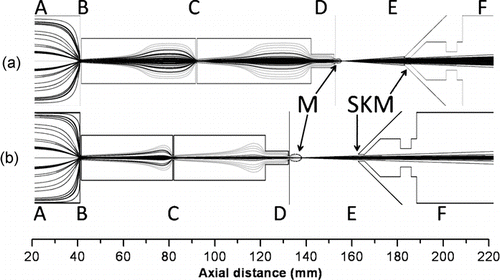
The CFD simulations of this ADL show a focusing of particles > 8 nm at the first orifice (). Smaller particles are focused at the second orifice. The distance between the orifices and the tube diameter is chosen not to permit the flow to fully reattach to the walls of the tube. This minimizes beam broadening by diffusion at low flow speed. The second nozzle is chosen to accelerate the particles as much as possible under the given flow parameters. The pressure drops from 605 to 25 Pa across this nozzle, thus a Mach zone develops downstream. It was found to be preferable not to place the skimmer in the zone of silence of the Mach zone. Since the particles are well focused while passing the Mach zone, they will not be defocused significantly. shows trajectories of 1–15 nm SiO2 particles dispersed in helium. After passing the skimmer and entering the octupole ion guide they have a sufficiently small radial momentum to be trapped by the pseudo potential of the octupole.
shows the static pressure, axial flow and particle axial velocity along the axis to be compared to the nanoparticle lens system “C” as introduced by CitationWang et al. (2006), therein. Obviously, the main difference is the higher axial particle speed in the new design which results in less Brownian broadening downstream from the lens.
FIG. 5 Static pressure, axial gas velocity and particle axial velocity (particle diameter 1 nm, 10 nm, 40 nm) along the axis of the nanoparticle lens system for the TRAPS apparatus. This figure can be compared to in CitationWang et al. (2006).
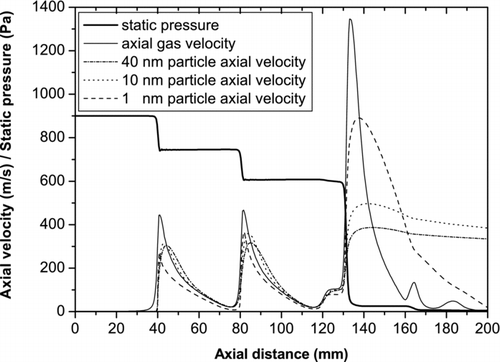
From the present CFD simulations it can be inferred, that the inlet pressure is a sensitive parameter of an ADL. If the pressure changes within 10% the focusing of a distinct size can be entirely lost. On the other hand, this sensitivity can be advantageously used to tune the lens to a specific particle diameter of interest. The focusing performance of an ADL is governed by the particle Stokes number S p . For S p = 1 a particle will be focused at the center line of the lens. Particles will pass the centre line at S p > 1 and diverge. For S p < 1, particles tend to follow the streamlines of the gas. The particle Stokes number has been derived by several groups (e.g., CitationPassig et al. 2006) to be:
This tuning effect is useful for variable composition gas mixtures, as well. For instance, aerosols created by a microwave plasma reactor are immersed in a carrier gas containing a variable amount of oxygen (O2) in helium depending on the amount of precursor used for the reaction. Since oxygen and helium have significantly different viscosity, the particle trajectories are sensitively changed. This can be compensated—at least to some extend—by varying the inlet pressure of the ADL.
It should be mentioned that the calculations were performed for an ideal geometry. Non-spherical particles will significantly vary the beam width (CitationLiu et al. 1995a, b). Nonsymmetric flow fields induce swirl effects at an orifice (CitationBaker 2000). Roughness at the edges of the orifices can cause nonstationary effects, such as fluctuating eddies downstream the orifice, resulting in turbulence and pulsation (CitationSigloch 2008).
2.4. Octopole Ion Trap
After passing through the ADL, the particles are decelerated and accumulated in a gas filled octupole ion guide located inside the vacuum chamber. An octupole ion guide was chosen because of its great acceptance angle and high trapping capacity. In the final development stage of the apparatus, this ion guide will serve for beam deceleration and shaping only. Tight focusing of the particle beam is not of primary relevance since in the final development stage subsequent ion guides are quadrupoles. For the purposes of this work the octupole ion guide was operated as a nanoparticle cage to demonstrate the prospects and limitations of such a device.
Linear octupole ion guides are standard radio frequency mass spectrometric devices. They are routinely used to guide, moderate, and cool ion beams (CitationGerlich 2003). Details and typical applications are given in a recent review (CitationDouglas et al. 2005). For the trap presented herein, the inner diameter of the octupole was chosen to be 9.52 mm and the rod diameter is 3.18 mm which is the optimum aspect ratio for octupole ion guides (CitationGerlich 2003). In order to adapt an octupole ion guide for the storage of singly charged nanoparticles, the RF frequency has to be adjusted to accommodate the high mass-to-charge-ratio of the particles. For nanoparticles in the 5–10 nm diameter regime, the RF frequency should range between 100 kHz and 30 kHz respectively. Tunable RF generators operating at such low frequencies are not commercially available. Some groups have developed ion traps which employ a digitally switched square wave pulse chain to drive nanoparticle ion traps (e.g., CitationDing et al. 2004). Theoretically, any periodic waveform can provide stable conditions for ion trapping. The drawbacks of this approach are the higher harmonics, which decrease the maximum trapping capacity of such traps, and also increase the noise problems to other sensitive equipment around that is generated by switching the high voltages. Therefore, a RF generator based on a ferrite core high voltage transformer driven by a push-pull feedback circuit was designed. It delivers sinusoidal RF voltages up to an amplitude of 2 kV at a tunable frequency between 20 kHz and 150 kHz and was used successfully for the present experiments (Meinen 2009). A further advantage of this approach is that a DC offset voltage can be superimposed easily to the sinusoidal output voltage in order to define the potential on the axis of the ion guide.
Applying an inert background gas, frictional forces are added to the electrodynamic forces. These forces allow to decelerate and to continuously store the ions within the octupole without the need for opening or closing the trap electrically. In the case of a light background gas, such as helium, moderating the much heavier nanoparticles, the action of the background gas can be regarded purely as friction applying the Cunningham correction to Stokes law. Filling of the trap and extraction of the nanoparticles are controlled by the electrostatic entrance and exit lenses of the trap. Typical operating conditions are depicted in .
FIG. 6 Schematic view and operating modes of the trap: (a) trap geometry; (b) filling/storage mode; (c) storage mode; (d) extraction mode.
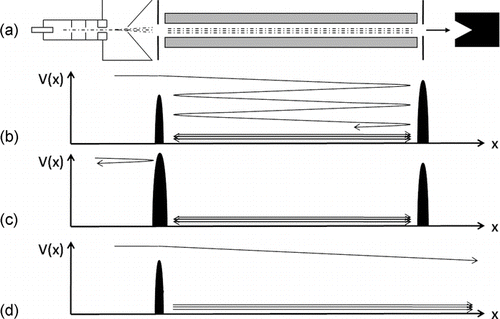
In the filling/storage mode (b), the entrance lens is kept at intermediate repelling potential which is below the kinetic energy of the incoming particles, while the exit lens is at a potential high enough to reflect all particles. By traversing the ion guide forth and back, the ions loose kinetic energy by collisions with the background gas. The decelerated returning ions are reflected by the entrance lens and are bound to travel between the entrance and exit electrode until their longitudinal kinetic energy is completely thermalized. In storage mode (c) both, entrance and exit lens are kept at such high repelling potential that particles can neither enter nor leave through the lenses. This mode is useful for leakage measurements, spectroscopic measurements, or chemical reactions. In order to extract the ions, the exit potential is switched to ground so that the particle can exit the trap (d). The ejected particle cloud is detected on a Faraday cup either directly or after being deflected by 90° in an electrostatic quadrupole bender.
A similar trap was used for laser driven charge reversal spectroscopy on small metal clusters. In this application, laser pulses were used to reverse the charge of the stored particles from negative to positive. The positively charged photoproducts were expelled from the trap via the entrance and exit electrodes by the same voltages that confined the anions, while the trap was continuously filled (CitationWolf et al. 1995). In the present experiments, the nanoparticles were extracted by pulsing the exit electrode to low potential.
A result from a typical trapping experiment is depicted in . The trap was kept in filling/storage mode for 0.5 s and then the exit lens was switched open at time t = 0 to extract the particles. The exit lens potential and the detector current are displayed in as a function of time. After a certain flight time, a large particle peak is measured, which reaches its maximum after 1.4 ms. After 1.8 ms the trap is emptied and the particle current reaches its cw value which can hardly be seen in the figure (the octupole trap works as an ion guide) until the exit lens is closed again after 4 ms. Integrating the particle peak yields the total charge stored in the trap, which reaches 2· 107 elementary charges in this case. From the cw value one can obtain the load current of the trap. Here, it is 70 pA corresponding to 4· 107 particles per second. Thus, for this configuration the particle density in the trap was enhanced by a factor of (66 ± 3). From the time interval between the opening of the ion trap and the signal on the Faraday cup, the diameter of the particles and their spatial distribution in the trap (cf. below) can be inferred.
3. RESULTS AND DISCUSSION
3.1. Characterization of the Plasma Particle Source
The plasma particle source and the ADL were characterized by SiO2 nanoparticles. For this purpose, an ADL was designed to fit at the existing Particle Mass Spectrometer (PMS) described in section 2.1. This lens consists of one focusing orifice with d f = 2.10 mm and an accelerating nozzle with d f = 2.13 mm, only. SiO2 particles where produced by the microwave plasma reactor using SiH4 and O2 in He at a total flow of 2.5 10−3 Pa L/s. The inlet pressure was 400 Pa for helium as a carrier gas and the pressure downstream the nozzle was 10 Pa. The flow limiting orifice was positioned close to the reactor in order to avoid coagulation of the particles. An aerodynamic skimmer with an opening of d f = 1.00 mm was positioned 15 mm downstream the nozzle in order to differentially pump to 0.01 Pa in the mass spectrometer.
Particles carrying one or two charges of both polarities have been detected by the PMS in comparable fractions. For the subsequent analysis, only singly (NP−) and doubly (NP2 −) negatively charged particles were used. The total current carried by the beam was about 350 pA; the current assigned to NP− and NP2– was 225 pA and 125 pA, respectively. By means of PMS, the diameter of the particles has been determined to be d p = (5.7 ± 0.8) nm. The axial velocity of the particles downstream from the skimmer has been measured to be (380 ± 40) ms−1 by using a chopped beam lock-in technique.
In order to compare the performance of this ADL inlet, the lens was replaced by a classical molecular beam inlet consisting of a flow-limiting orifice in front of an aerodynamic skimmer with an opening of d f = 0.50 mm. This skimmer was placed 15 mm upstream the nozzle. shows the signal intensity of the deflected particle beam for two inlet systems, the ADL (boxes) and the molecular beam (circles) inlet. Note that the signal recorded using the molecular beam inlet is multiplied by a factor of 100 in order to facilitate a comparison between both experiments. The total current carried by the beam was about 350 pA and 2.5 pA for the ADL and the molecular beam inlet, respectively. The particles produced for the experiment with the molecular beam inlet (circles) are about 0.5 nm smaller than the particles used for the ADL inlet experiment (boxes). This is due to a slightly higher pressure within the microwave plasma reactor in the molecular beam inlet case. As the mass flow of the precursors has been carefully controlled, it can be assumed that more particles of smaller size have been produced in the plasma in order to transform all reactants. For this reason the amplification of the transmitted particle beam caused by the ADL might be even higher.
These experiments demonstrate that the microwave plasma source is a reliable source for intense beams of small nanoparticles in a carrier gas at moderate pressure. A carefully designed aerodynamic lens enhances the fraction of particles that can be transferred into a vacuum system by about a factor of 100.
3.2. Characterization of the Aerodynamic Lens Inlet
The aim of this work is to design an ADL for use as a nanoparticle inlet for the TRAPS device, as depicted in . The parameters of the ADL used for the following experiments are listed in . The skimmer with an opening of d f = 3.0 mm is positioned 15 mm downstream the nozzle. The distance between skimmer and inlet lens of the octupole is 23 mm. The length of the octupole is 220 mm and the distance between octupole and electrometer is 162 mm, whereas the detection area has a diameter of 17 mm. SiO2 particles with d p = (6.0 ± 0.7) nm were produced by microwave plasma synthesis at 10 kPa and characterized with the TRAPS-TOF device (see section 3.4).
It was shown above that the inlet pressure of the ADL is the key parameter for the focusing performance of the lens since it defines the pressure and velocity of the carrier gas inside the lens. shows an experiment demonstrating this relationship. A rotary pump is connected to the tube between flow limiting orifice and first focusing orifice. The pressure, which is referred to as inlet pressure, is adjusted by a valve and controlled by a capacitive pressure gauge. clearly shows a maximum signal at 860 Pa which is close to the pressure the lens was designed for (900 Pa, see ). An increase of the inlet pressure leads to an increase of the mass flow through the ADL. Therefore, the measurement is corrected for the change of the mass flow (filled spheres in ). The corrected signal can be interpreted as a transmission efficiency of the whole inlet system consisting of ADL, skimmer, and octupole. CFD calculations indicate that the peak at 473 Pa might be induced by particles with larger aerodynamic diameter. A similar effect was reported by (Citationde la Mora 1996) who noticed a stepped collection efficiency of aerodynamic particle impactors for different gas velocities. De la Mora was able to address this effect to varying classes of particle sizes. Our CFD simulations show a high skimmer transmission of 12 nm diameter particles at 473 Pa but a complete loss of particles at 860 Pa, so it can be assumed that the second peak in can be assigned to agglomerates of primary particles.
FIG. 8 Transmission of the aerodynamic lens in dependence of the inlet pressure of the lens probed with (6.0 ± 0.4) nm diameter SiO2 particles. Open boxes represent the detector current. In order to have a relative measure for the transmission efficiency of the ADL the data was corrected for the gas flow increasing with inlet pressure.
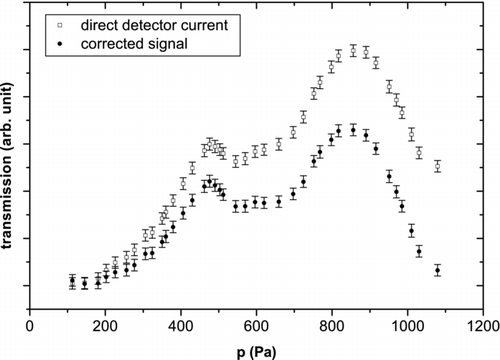
The requirements to the beam divergence downstream the ADL are quite low in our application, since the beam is focused electrodynamically once it is inside the octupole ion guide. According to CitationLiu et al. (1995a) the minimum divergence of a nanoparticle beam exiting an ADL is determined by the Brownian motion which adds a radial velocity component to the particle beam exiting from the nozzle. Assuming that upstream of the nozzle particles are in perfect thermal equilibrium with the surrounding gas, the velocity distribution of the particle thermal agitation can be approximately described by the Maxwell-Boltzmann distribution. Downstream the nozzle gas-particle collisions are assumed to be negligible since the pressure is low. From this it follows for the beam diameter d B,Brown at a certain distance L downstream the nozzle:
Beam profiles have been measured by sliding a sharp edged copper plate into the beam. The analysis of the Faraday cup signal over plate position yields the beam profile. Beam diameters are defined following CitationLiu et al. (1995a) as the width containing 90% of the particles. shows the particle beam diameter of 7 nm SiO2 particles measured 235 mm downstream the nozzle. CFD simulations with appropriate parameters show a minimum at the working pressure of the lens and, as expected, a significantly smaller beam size since the CFD code does not account for Brownian broadening.
FIG. 9 Beam diameter 235 mm downstream the nozzle recorded for (7.0 ± 0.6) nm SiO2 with different inlet pressure of the ADL. The profiles are compared to the results from CFD calculations, which show a minimum at the working pressure of the lens and an overall lower beam diameter. The Brownian limit of a 7 nm particle beam according to Equation (Equation3) is depicted for comparison.
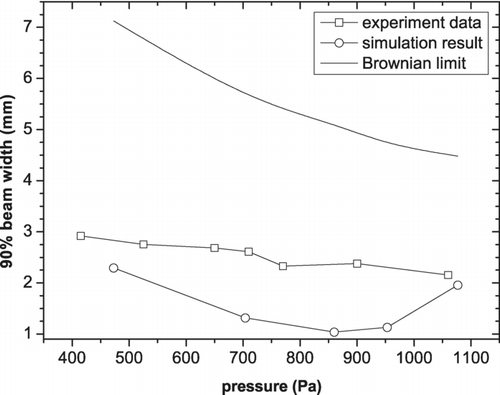
shows the ADL would be able to focus the beam to 1 mm diameter at the working pressure if Brownian motion would be absent. Brownian broadening determines the width of the beam over the full pressure range tested. The beam width measured at working pressure is about 2.4 mm. Assuming Equation (Equation2) is valid, this beam diameter corresponds to 12 nm particle diameter while it was determined by time-of-flight (TOF) measurement to be d p = (7.0 ± 0.6) nm (cf. below). The theoretical Brownian limit for a 7.0 nm particle is calculated from Equation (Equation2) is depicted as dashed line in . This might be an indication that the assumptions made in the derivation of Equation (Equation2) are not completely valid. The particles are possibly not in perfect thermal equilibrium with the surrounding carrier gas while passing the acceleration nozzle of the ADL. Furthermore, in the discussion of the octupole ion trap downstream from the skimmer (cf. below) evidence will be presented that the drag force of the low background gas pressure inside the ion guide is influencing the particle trajectories. CFD simulations show that trajectories of particles with diameter d p < 5.0 nm are influenced by the gas flow through the exit lens of the octupole ion guide. This is an indication for an additional focusing effect of the skimmer and the octupole ion guide geometry.
3.3. Characteristics of the Nanoparticle Trap
The trapping capacity of the octupole ion trap is the key parameter for being able to do optical or X-ray spectroscopy on small nanoparticles. Up to 107 particles per cubic centimeter are required to achieve a measurable optical absorption signal in the visible for strongly absorbing materials like iron oxide particles. The spatial distribution of the trapped particles will extend to larger radii with increasing particle number since space charge effects add to the pseudo potential of the electrodynamic trap. These processes are very well characterized by CitationDouglas et al. (2005); CitationGerlich (2003); and CitationTerasaki et al. (2009).
The storage characteristics of the trap were assessed by accumulating particles for various time periods by analyzing the ion pulses leaving the trap. SiO2 particles from a microwave plasma source were used. The diameter of the particles was determined by the TRAPS-TOF device (see section 3.4) to be d p = (6.4 ± 0.5) nm. The particles were transferred by the ADL into the vacuum as shown in . After passing the skimmer, the particles enter the octupole ion guide. The background pressure of the gas inside the octupole is 1.8 Pa. The pressure downstream from the octupole was 0.03 Pa with a helium gas flow of 31 Pa· L· s−1 through the experiment. The octupole was driven with a sinusoidal waveform at a frequency f = 50 kHz, an amplitude of 255 V and an DC offset voltage of –186 V. This provides a beam current of 100 pA as measured by the electrometer at the straight through Faraday cup. A voltage of –350 V was applied at the exit lens of the ion guide for trapping the particles in the octupole ion trap. This potential could be switched to ground by a fast MOSFET-Push-Pull switch (HTS 61-03-GSM, BEHLKE Electronic GmbH, Germany) within 500 ns for a period of 40 ms.
shows exit pulses for increasing filling time. It is interesting to notice that the pulses first grow in height and then, for prolonged filling time, they grow preferentially in width. This indicates that the trap seems to be gradually filled beginning from the exit lens toward the inlet. Obviously, the particles are concentrated at the exit of the octupole by the drag force of the gas flow through the octupole. The average distance between two particles in a maximum loaded trap is about 30 μ m. Thus a Coulomb repulsion of 3· 10−19 N is acting between the two particles. A drag force of the same order of magnitude caused by the gas flowing through the ion guide is acting on the particles and pushes them towards the exit of the ion guide. shows the total number of particles trapped as a function of the filling time. A maximum trap capacity of 5· 108 particles is reached at a filling time of about 10 s with a beam of 6.2· 108 particles per second entering the trap. If one assumes that the particle cloud extends to the octupole rods, the particle density is 4· 107 particles per cubic centimeter. This is in perfect agreement with the theoretically predicted maximum trap capacity of 3.7· 107 particles per cubic centimeter (CitationDouglas et al. 2005).
FIG. 10 Particle pulses obtained from the octupole ion trap for various filling times dt. (a) dt = 0.2 s, (b) dt = 0.5 s, (c) dt = 1.5 s, (d) dt = 10 s. The intensity of the filling beam was 0.1 nA.
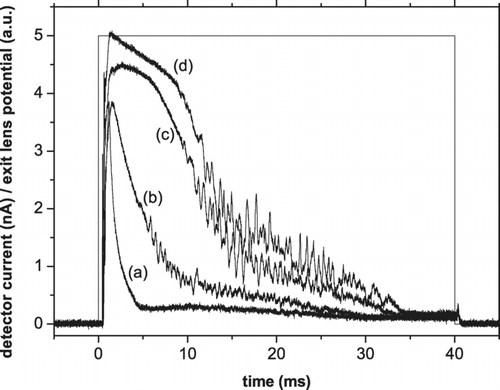
FIG. 11 Storage capacity of the octupole ion trap. (6.4 ± 0.6) nm SiO2 particles have been filled into the octupole ion trap with a current of 0.1 pA singly charged ions.
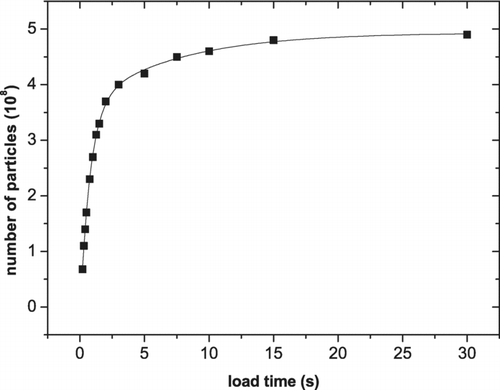
The maximum trap capacity is limited by the number of particles leaking out of the trap. The leakage is due to particle–particle Coulomb interaction in near collisions, which diphase the particle motion from the RF field. It can be measured by varying the storage time. If a constant leakage factor C l is assumed, the decay of the particle concentration N(t) can be described by
shows the decrease of the stored particles in the trap as a function of storage time. A linear fit to ln[N(t)/N 0] over t yields a leakage factor of C = 8.5· 10−2 s−1. Thus the mean residence time of the particles in the almost full octupole ion trap is 12 s. This experiment demonstrates the stability of rigid, non-volatile particles inside the trap. But it is known from experiments with flexible bio-molecules that even very labile particles can be trapped in an electrodynamic potential for hours (e.g., CitationIavarone et al. 2006). If the trapped particles have semi-volatile components, the storage time of the particles might become limited by their evaporation rate.
FIG. 12 Particle retention rates of the octupole trap in storage mode as a function of storage time. The experiment was performed with a beam of 0.1 pA (= 1.2 109 particles s−1) singly charged (6.4 ± 0.6) nm diameter SiO2 particles.
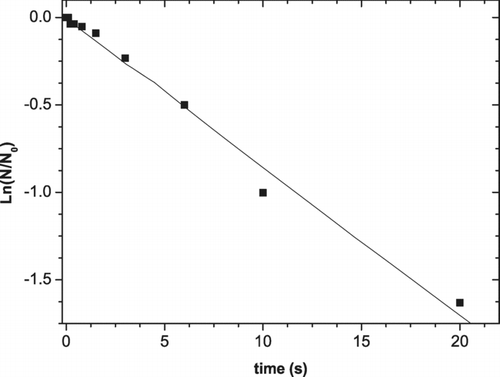
The interpretation that the gas flow inside the trap determines the spatial distribution of the particles is supported by the observation that under normal operating conditions no potential at the entrance lens of the octupole is needed in order to trap particles. Obviously they are held inside the trap by the drag force exerted by the gas flow.
3.4. Time of Flight Measurements
From the time interval between the opening of the ion trap and the signal on the Faraday cup, the diameter of the particles and their spatial distribution in the trap can be inferred (cf. below). For these measurements the trap is filled with a comparatively small number of particles in order to minimize space charge effects and to obtain sharp exit pulses. By varying the offset potential of the octupole trap, the kinetic energy of the exiting particles can be varied. In extraction pulses are shown that were obtained by filling a total number of 105 particles into the trap before opening the exit lens for 4 ms. The DC offset potential U DC of the octupole rods relative to ground was –179 V and –155 V for the first and second pulse, respectively. A shift in time occurring from the different acceleration of the ions with the mass m and the charge q is evident. Since the initial velocity v 0 of the particles is a priory unknown, a series of flight times t i at different accelerating offset potentials was measured in order to eliminate the initial velocity from the mass analysis. The kinetic energy is assumed to be the sum of initial kinetic energy and acceleration by U DC (Equation (Equation5)).
FIG. 13 Exit lens potential and time of flight signals for SiO2 particles starting from different potentials. The left peak is achieved by U DC = −179 V and yields a flight time of 0.61 ms. The right peak is achieved by U DC = −155 V and yields a flight time of 0.74 ms.
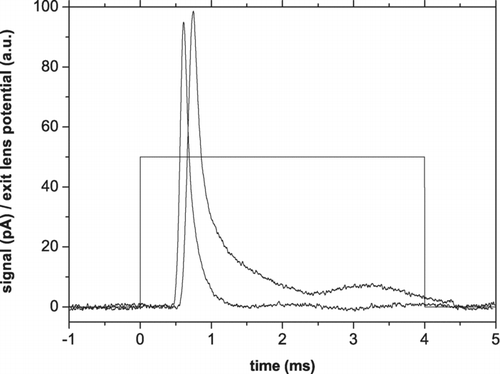
TOF measurements of NaHCO3 particles have been compared to particle diameters determined by SMPS (DMA Classifier: TSI model 3085, CPC: TSI model 3025) in order to verify this new method. shows a particle diameter distribution of NaHCO3 particles in a helium atmosphere produced by an atomizer at atmospheric pressure. The diameter distribution measured by the SMPS peaks at 9.8 nm and has a FWHM of about 3 nm. The mean diameter measured by the TOF is d p = (11.7 ± 2.2) nm. This indicates that both approaches yield virtually the same results, indicating the reliability of the present work.
4. CONCLUSION AND OUTLOOK
We have developed a novel apparatus that allows gas-born nanoparticles in a diameter range from 3 to 15 nm to be efficiently transferred into a vacuum apparatus and to store them there for a prolonged time for further analysis. We were able to store up to 5 108 particles in a 20 cm long ion guide with a diameter of about 9 mm. This target density suffices for direct absorption measurements in the visible, UV-, and X-ray regime. A simple time of flight detection scheme allows us to estimate the particle diameter.
This apparatus will be transformed in the future into a complete nanoparticle spectrometer including a cooled nanoparticle trap and a second mass selective nanoparticle mass spectrometer named TRAPS. This should allow assessing chemical reactions of free nanoparticles, including ice nucleation or halogen activation reactions.
We wish to thank V. Szabo for support with the design and buildup of the microwave plasma particle source. We also give thanks to ANSYS and CADFEM for their support and fruitful help with the CFD code design and Johan Söderström for working with us on the simulation of aerodynamic lenses. This work was supported through the framework of FSP 301—FLASH (Förderkennzeichen 05 KS7VHA) of the German Federal Ministry for Education and Research, Bonn, Germany.
REFERENCES
- Allen , M. D. and Raabe , O. G. 1985 . Slip Correction Measurements of Spherical Solid Aerosol Particles in an improved Millikan Apparatus. . Aerosol Sci. Technol. , 4 : 269 – 286 .
- ANSYS CFX–Solver Modeling Guide ANSYS CFX Release 11.0. © 1996–2006 ANSYS Europe, Ltd. (2005) 566 pages.
- ANSYS CFX–Solver Theory Guide ANSYS CFX Release 11.0. © 1996–2006 ANSYS Europe, Ltd. (2006) 312 pages.
- Baker , R. C. 2000 . Flow Measurement Handbook: Industrial Designs, Operating Principles, Performance, and Applications , 524 New York : Cambridge University Press .
- Baumann , W. , Thekedar , B. , Paur , H.-R. and Seifert , H. 2006 . Characterization of Nanoparticles Synthesized in the Microwave Plasma Discharge Process by Particle Mass Spectrometry and Transmission Electron Microscopy. AIChE Annual Meeting November 12–17, San Francisco
- Chen , D. R. , Pui , D. Y. and Kaufman , S. L. 1995 . Electrospraying of Conducting Liquids for Monodisperse Aerosol Generation in the 4 nm to 1.8 μ m Diameter Range. . J. Aerosol Sci. , 26 : 963 – 977 .
- Chen , D. R. , Pui , D. Y. H. , Hummes , D. , Fissan , H. , Quant , F. R. and Sem , G. J. 1998 . Design and evalution of a nanometre aerosol differential mobility analyzer. . J. Aerosol Science , 29 : 497 – 509 .
- Cole , R. B. 1997 . Electrospray ionization mass spectrometry: Fundamentals, instrumentation and applications. , 600 New York : Wiley .
- Ding , L. , Sudakov , M. , Brancia , F. L. , Giles , R. and Kumashiro , S. 2004 . A Digital Ion Trap Mass Spectrometer Coupled with Atmospheric Pressure Ion Sources. . J. Mass Spectrom. , 39 : 471 – 484 .
- Douglas , D. J. , Frank , A. J. and Dunmin , M. 2005 . Linear Ion Traps in Mass Spectrometry. . Mass Spectrom. Rev. , 24 : 1 – 29 .
- Fuchs , N.A. 1963 . On the Stationary Charge Distribution on Aerosol Particles in a Bipolar . Ionic Atmosphere. Geophys. Pura Appl. , 56 : 185 – 193 .
- Gadsden , M. 1982 . Noctilucent Clouds. . Space Science Review , 33 : 279 – 334 .
- Gerlich , D. 2003 . Molecular Ions and Nanoparticles in RF and AC Traps. . Hyperfine Interactions , 146/147 : 293 – 306 .
- Grimm , M. , Langer , B. , Schlemmer , S. , Lischke , T. , Becker , U. , Widdra , W. , Gerlich , D. , Flesch , R. and Rühl , E. 2006 . Charging Mechanisms of Trapped Element-Selectively Excited Nanoparticles Exposed to Soft X Rays. . Phys. Rev. Lett. , 96 : 066801
- Huffman , J. , Jayne , J. , Drewnick , F. , Aiken , A. , Onasch , T. and Worsnop , D. 2005 . Design, Modeling, Optimization, and Experimental Tests of a Particle Beam Width Probe for the Aerodyne Aerosol Mass Spectrometer. . Aerosol Sci. Technol. , 39 : 330 – 337 .
- Iavarone , A. T. , Meinen , J. , Schulze , S. and Parks , J. H. 2006 . Fluorescence Probe of Polypeptide Conformational Dynamics in Gas Phase and in Solution. . Int. J. Mass Spec , 253 : 172 – 180 .
- Kuhn , H. R. , Koch , J. , Hergenröder , R. , Niemax , K. , Kalberer , M. and Günther , D. 2005 . Evaluation of Different Techniques for Particle Size Distribution Measurements on Laser-Generated Aerosols. . J. Anal. At. Spectrom. , 20 : 894 – 900 .
- Kruis , F. E. , Fissan , H. and Peled , A. 1998 . Synthesis of Nanoparticles in the Gas Phase for Electronic, Optical and Magnetic Applications—A Review. . J. Aerosol Sci. , 29 : 511 – 535 .
- Lee , K. S. , Cho , S. W. and Lee , D. 2008 . Development and Experimental Evaluation of Aerodynamic Lens as an Aerosol Inlet of Single Particle Mass Spectrometry. . J. Aerosol Sci. , 39 : 287 – 304 .
- Liu , B. Y. H. and Lee , K. W. 1975 . An Aerosol Generator of High Stability. . Am. Ind. Hyg. Assoc. J. , 36 : 861 – 865 .
- Liu , P. , Ziemann , P. J. , Kittelson , D. B. and McMurry , P. H. 1995a . Generating Particle Beams of Controlled Dimensions and Divergence: I. Theory of Particle Motion in Aerodynamic Lenses and Nozzle Expansions . Aerosol Sci. Technol. , 22 : 293 – 313 .
- Liu , P. , Ziemann , P. J. , Kittelson , D. B. and McMurry , P. H. 1995b . Generating Particle Beams of Controlled Dimensions and Divergence: II. Experimental Evaluation of Particle Motion in Aerodynamic Lenses and Nozzle Expansions . Aerosol Sci. Technol , 22 : 314 – 324 .
- Liu , P. S. K. , Deng , R. , Smith , K. A. , Williams , L. R. , Jayne , J. T. , Canagaratna , M. R. , Moore , K. , Onasch , T. B. , Worsnop , D. R. and Deshler , T. 2007 . Transmission Efficiency of an Aerodynamic Focusing Lens System: Comparison of Model Calculations and Laboratory Measurements for the Aerodyne Aerosol Mass Spectrometer . Aerosol Sci. Technol. , 41 : 721 – 733 .
- Mätzing , H. , Baumann , W. , Paur , H.-R. and Seifert , H. 2009 . Chemical Model of Ar/O2 Microwave Plasma with Nanoparticle Formation from Metal Precursors . Proceedings 19th International Symposium on Plasma Chemistry, Bochum , : 26 – 31 . July, 2009
- Meinon , J. , Östemeicher , B. and Leisner , T. 2009 . Patent Pending at German Patent Office . Reference Number , 10 2009 023 700.3
- de la Mora , J. F. 1996 . Drastic Improvement of the Resolution of Aerosol Size Spectrometers via Aerodynamic Focusing: The Case of Variable-Pressure Impactors . Chem. Engineering Comm , 151 : 1,101 – 104 .
- Naumann , K. H. 2003 . COSIMA—A Computer Program Simulating the Dynamics of Fractal Aerosols . J. Aerosol Science. , 34 : 1371 – 1397 .
- Passig , J. , Meiwes-Broer , K.-H. and Tiggesbäumker , J. 2006 . Collimation of Metal Nanoparticle Beams Using Aerodynamic Lenses . Rev. Sci. Instr , 77 : 093304
- Paur , H.-R. , Baumann , W. , Mätzing , H. and Seifert , H. 2005 . Formation of Nanoparticles in Flames; Measurement by Particle Mass Spectrometry and Numerical Simulation . Nanotechnology , 16 : 355 – S361 .
- Rapp , M. and Lübken , F.-J. 2004 . Polar Mesosphere Summer Echoes (PMSE): Review of Observations and Current Understanding . Atmos. Chem. Phys , 4 : 2601 – 2633 .
- Shaw , D. T. and Liu , B. 2008 . Handbook of Micro and Nanoparticle Science and Technology , Heidelberg : Springer .
- Shu , J. N. , Wilson , K. R. , Ahmed , M. and Leone , S. R. 2006a . Coupling A Versatile Aerosol Apparatus to a Synchrotron: Vacuum Ultraviolet Light Scattering, Photoelectron Imaging, and Fragment Free Mass Spectrometry . Rev. Sci. Instrum. , 77 : 043106
- Shu , J. , Wilson , K. R. , Ahmed , M. , Leone , S. R. , Graf , C. and Rühl , E. 2006b . Elastic Light Scattering from Nanoparticles by Monochromatic Vacuum-Ultraviolet Radiation . J. Chem. Phys , 124 : 034707
- Sigloch , H. 2008 . Technische Fluidmechanik , Springer-Verlag : Berlin Heidelberg . 581. 6. Auflage
- Szabo , D. V. , Vollath , D. , Taylor , R. D. and Willis , J. O. 1997 . Synthesis and Magnetic Properties of Nanostructured Maghemite . J. Mater. Res , 12 : 2175 – 2182 .
- Szabo , D. V. and Vollath , D. 1999 . Nanocomposites from Coated Nanoparticles . Adv. Mater , 11 : 1313 – 1316 .
- Terasaki , A. , Majima , T. , Kasai , C. and Kondow , T. 2009 . Photon-Trap Spectroscopy of Size-Selected Free Cluster Ions: “Direct” Measurement of Optical Absorption of Ag9 + . Eur. Phys. J. D , 52 : 43 – 46 .
- 2008 . Aerosol Electrospray TSI User's Manuel Model 3480
- Vollath , D . 2008 . Plasma Synthesis of Nanopowders . Journal Nanopart. Res , 10 : 39 – 57 .
- Wang , X. , Gidwani , A. , Girshick , S. L. and McMurry , P. H. 2005 . Aerodynamic Focusing of Nanoparticles: II. Numerical Simulation of Particle Motion Through Aerodynamic Lenses . Aerosol Sci. Technol. , 39 : 624 – 636 .
- Wang , S. , Zordan , C. A. and Johnston , M. V. 2006 . Chemical Characterization of Individual, Airborne Sub-10-nm Particles and Molecules . Anal. Chem. , 78 : 1750 – 1754 .
- Wang , X. and McMurry , P. 2006 . A Design Tool for Aerodynamic Lens Systems . Aerosol Sci. Technol. , 40 : 320 – 334 .
- Wang , S. and Johnston , M. V. 2006 . Airborne Nanoparticles Characterization with a Digital Ion Trap–Reflectron Time of Flight Mass Spectrometer. . Intl. J. Mass Spec. , 258 : 50 – 57 .
- Wolf , S. , Sommerer , G. , Rutz , S. , Schreiber , E. , Leisner , T. and Woste , L. 1995 . Spectroscopy of Size-Selected Neutral Clusters—Femtosecond Evolution of Neutral Silver Trimers. . Phys. Rev. Lett. , 74 : 4177 – 4180 .
- Zhang , X. , Smith , K. A. , Worsnop , D. R. , Jiménez , J. , Jayne , J. T. , Kolb , C. E. , Morris , J. and Davidovits , P. 2004 . Numerical Characterization of Particle Beam Collimation: Part II Integrated Aerodynamic Lens–Nozzle System. . Aerosol Sci. Technol. , 38 : 619 – 638 .
- Ziemann , P. Z. , Liu , P. L. , Rao , N. P. , Kittelson , D. B. and McMurry , P. H. 1995 . Particle Beam Mass Spectrometry of Submicron Particles Charged to Saturation in an Electron Beam . J. Aerosol Sci. , 26 : 745 – 756 .
- Zierep , J. 1993 . Grundzüge der Strömungslehre 5. Auflage, Springer, Berlin.
